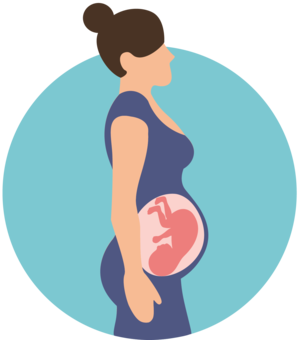Pregnancy at week 39
4-minute read
Your baby
Your baby’s weight gain will probably slow down now because they are almost ready to be born. They will likely weigh about 3.3kg and measure between 35cm and 36cm, although babies are born in all shapes and sizes.
They now look like a newborn baby. If they are a boy, the testicles are fully descended into the scrotum. They will have a lot of fat underneath their skin and they will be covered in creamy white vernix.
Your baby at 39 weeks
| Length: | 35-36cm (head to bottom) |
| Weight: | 3.3kg |

Your body
Your cervix will be growing thinner in preparation for the birth. It will gradually soften and open until it is 10cm wide. You may have a lot of vaginal discharge and you may get a ‘show’ – when you discharge the plug of mucus that was keeping your cervix closed. This is all part of the first stage of labour.
You may lose a little blood mixed in with the mucus, but if you notice you’re bleeding it’s important to call the doctor or midwife straight away since it could be the sign of something more serious.
The placenta has grown to around 17cm or 18cm across and can weigh as much as 1kg. It will be delivered after the baby if you have a vaginal birth.
Things to remember
Most women won’t need any more scans now. But if you have complications, such as gestational diabetes or pre-eclampsia, or if you are having multiple babies, your doctor may want to do an ultrasound to check that everything is OK. They will monitor you carefully if your baby is in the breech position or to see where the placenta is.
Unless your doctor or midwife has told you otherwise, you should stay at home as long as you can after labour starts. Try to rest as much as you can. When the pain becomes more intense and there is less than 3 to 5 minutes between each contraction, it’s time to go.
Make sure you have everything packed for going to hospital – clothes, toiletries and sanitary pads for you, and clothes and nappies for the baby. It’s also a good idea to stock the fridge for when you come back, so you don’t have to think about cooking with a newborn in the house.
If you’re planning to have the baby at home, make sure you have lots of clean towels and sheets, a large plastic sheet to cover the birthing area and enough drinks and snacks for you and your support person. The midwife will bring most of the equipment needed for the birth.
Read next

Your pregnancy at 40 weeks
Learn about your pregnancy journey and what is happening to you and your baby.

Speak to a maternal child health nurse
Call Pregnancy, Birth and Baby to speak to a maternal child health nurse on 1800 882 436 or video call. Available 7am to midnight (AET), 7 days a week.
Learn more here about the development and quality assurance of healthdirect content.
Last reviewed: August 2020



